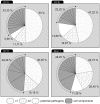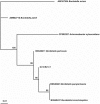Molecular identification of bacteria by total sequence screening: determining the cause of death in ancient human subjects
- PMID: 21765907
- PMCID: PMC3135582
- DOI: 10.1371/journal.pone.0021733
Molecular identification of bacteria by total sequence screening: determining the cause of death in ancient human subjects
Abstract
Research of ancient pathogens in ancient human skeletons has been mainly carried out on the basis of one essential historical or archaeological observation, permitting specific pathogens to be targeted. Detection of ancient human pathogens without such evidence is more difficult, since the quantity and quality of ancient DNA, as well as the environmental bacteria potentially present in the sample, limit the analyses possible. Using human lung tissue and/or teeth samples from burials in eastern Siberia, dating from the end of 17(th) to the 19(th) century, we propose a methodology that includes the: 1) amplification of all 16S rDNA gene sequences present in each sample; 2) identification of all bacterial DNA sequences with a degree of identity ≥ 95%, according to quality criteria; 3) identification and confirmation of bacterial pathogens by the amplification of the rpoB gene; and 4) establishment of authenticity criteria for ancient DNA. This study demonstrates that from teeth samples originating from ancient human subjects, we can realise: 1) the correct identification of bacterial molecular sequence signatures by quality criteria; 2) the separation of environmental and pathogenic bacterial 16S rDNA sequences; 3) the distribution of bacterial species for each subject and for each burial; and 4) the characterisation of bacteria specific to the permafrost. Moreover, we identified three pathogens in different teeth samples by 16S rDNA sequence amplification: Bordetella sp., Streptococcus pneumoniae and Shigella dysenteriae. We tested for the presence of these pathogens by amplifying the rpoB gene. For the first time, we confirmed sequences from Bordetella pertussis in the lungs of an ancient male Siberian subject, whose grave dated from the end of the 17(th) century to the early 18(th) century.
Conflict of interest statement
Figures



Similar articles
-
The ancient Yakuts: a population genetic enigma.Philos Trans R Soc Lond B Biol Sci. 2015 Jan 19;370(1660):20130385. doi: 10.1098/rstb.2013.0385. Philos Trans R Soc Lond B Biol Sci. 2015. PMID: 25487336 Free PMC article.
-
Rapid and reasonable molecular identification of bacteria and fungi in microbiological diagnostics using rapid real-time PCR and Sanger sequencing.J Microbiol Methods. 2019 Apr;159:148-156. doi: 10.1016/j.mimet.2019.03.005. Epub 2019 Mar 9. J Microbiol Methods. 2019. PMID: 30858006
-
Usefulness of the MicroSeq 500 16S ribosomal DNA-based bacterial identification system for identification of clinically significant bacterial isolates with ambiguous biochemical profiles.J Clin Microbiol. 2003 May;41(5):1996-2001. doi: 10.1128/JCM.41.5.1996-2001.2003. J Clin Microbiol. 2003. PMID: 12734240 Free PMC article.
-
Then and now: use of 16S rDNA gene sequencing for bacterial identification and discovery of novel bacteria in clinical microbiology laboratories.Clin Microbiol Infect. 2008 Oct;14(10):908-34. doi: 10.1111/j.1469-0691.2008.02070.x. Clin Microbiol Infect. 2008. PMID: 18828852 Review.
-
Paleomicrobiology of Human Tuberculosis.Microbiol Spectr. 2016 Aug;4(4). doi: 10.1128/microbiolspec.PoH-0003-2014. Microbiol Spectr. 2016. PMID: 27726782 Review.
Cited by
-
Tuberculosis epidemiology and selection in an autochthonous Siberian population from the 16th-19th century.PLoS One. 2014 Feb 26;9(2):e89877. doi: 10.1371/journal.pone.0089877. eCollection 2014. PLoS One. 2014. PMID: 24587092 Free PMC article.
-
Historic and Prehistoric Epidemics: An Overview of Sources Available for the Study of Ancient Pathogens.Epidemiologia (Basel). 2022 Oct 7;3(4):443-464. doi: 10.3390/epidemiologia3040034. Epidemiologia (Basel). 2022. PMID: 36547255 Free PMC article. Review.
-
False positives complicate ancient pathogen identifications using high-throughput shotgun sequencing.BMC Res Notes. 2014 Feb 25;7:111. doi: 10.1186/1756-0500-7-111. BMC Res Notes. 2014. PMID: 24568097 Free PMC article.
-
Hybridization-based detection of Helicobacter pylori at human body temperature using advanced locked nucleic acid (LNA) probes.PLoS One. 2013 Nov 22;8(11):e81230. doi: 10.1371/journal.pone.0081230. eCollection 2013. PLoS One. 2013. PMID: 24278398 Free PMC article.
References
-
- Drancourt M, Raoult D. Palaeomicrobiology: Current issues and perspectives. Nature Reviews Microbiology. 2005;3:23–35. - PubMed
-
- Wiechmann I, Grupe G. Detection of Yersinia pestis DNA in two early medieval skeletal finds from Aschheim (Upper Bavaria, 6th century A.D.). Am J Phys Anthropol. 2005;126:48–55. - PubMed
Publication types
MeSH terms
Substances
LinkOut - more resources
Full Text Sources

